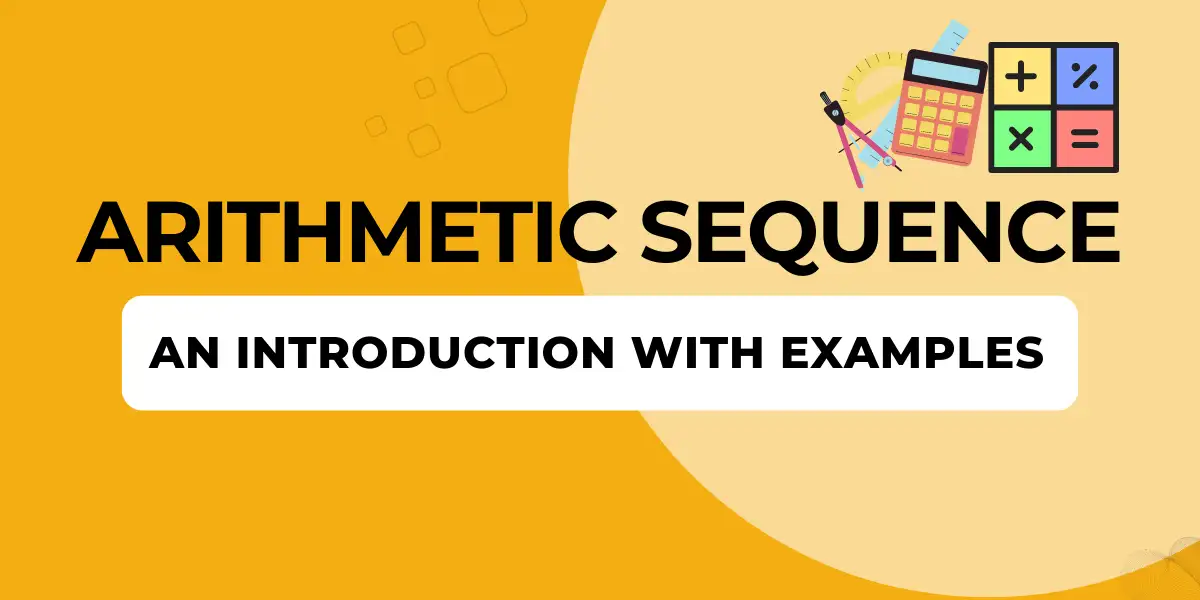Arithmetic Progression Class 10
By Truemaths Tech, Last Updated 21 Jul, 2023 6 min read

- NCERT Video Solutions Class 10 Maths Chapter 5 Arithmetic Progression Class 10
- What is Arithmetic Progression or AP?
- How to find that any series is an Arithmetic Progression?
- Arithmetic Progression (AP) Formula class 10:-
- What is the formula to find the nth term of an AP?
- What is the formula for the sum of n terms-Arithmetic Progression?:-
- Types
- Important Notes
Arithmetic Progression Class 10
This is another important concept, Arithmetic Progression, for class 10 students preparing for CBSE/ICSE board examinations. Arithmetic Progression in the NCERT curriculum is introduced for class 10th in Chapter 5. In the Class 10 Arithmetic Progression chapter, both important formulas to find the general term and to find the sum of n terms in an A.P. are discussed in length.
According to the definition given in the NCERT book, “An Arithmetic Progression is a list of numbers in which each term is obtained by adding a fixed number to the preceding term, except the first term. This fixed number is called the common difference of the AP. And it can be positive, negative or zero”.
There are some examples for better understanding:
- If the weight of people in a family is 30kg, 35kg, 40kg, 45kg,…
- Rahul’s savings in Rs. for the first six months are 2000, 2500, 3000, 3500, 4000, 4500 . . .
- If the temperature (in Celsius) of an Indian State is measured as 24°, 26°, 28°, 30°, 32°. . .
In all of the above examples, the common difference is constant.
NCERT Video Solutions Class 10 Maths Chapter 5 Arithmetic Progression Class 10
Truemaths has all the NCERT video Solutions for Class 10 Maths Chapter 5 Arithmetic Progressions. In these video lectures, we have explained every detail about this chapter and the terms related to this chapter. We have also recorded NCERT Maths exercise questions for chapter 5. Visit Truemaths to get all the video solutions.
You can also download Truemaths APP to get all the NCERT Maths video solutions for class 10.
What is an Arithmetic Progression or AP?
In Mathematics, a series is called an Arithmetic progression or Arithmetic sequence if all the numbers in a series are placed in such a way that the difference between the consecutive terms is equal or constant. Here difference (also known as the common difference “d”) means the second term minus 1st term.
Additionally, an Arithmetic Progression (AP) is a series that is increasing or decreasing by adding or subtracting a constant term to the previous term of the series.
Arithmetic progression example:-
The series of all natural numbers is in AP as we are adding 1(constant) to write the next term.
(e.g.- 1,2,3,4,5………. )
The series of all even & odd numbers is in AP, having the same common difference as 2.
Like in odd numbers here 1, 3, 5, 7, 9, 11, 13 . . . ; this Series is an arithmetic progression with common difference of two.
How to find that any series is an Arithmetic Progression?
The easiest way to know, either the series is an AP or not, is finding the difference between the consecutive numbers. In Arithmetic Progression the difference between two consecutive terms is always constant or equal.
Or
Quantities in AP are always increasing or decreasing by a constant term, also known as common difference, denoted by “d”.
For example:
In an Even numbers series = 4 , 6 , 8,10 . . . .
In an Odd numbers series = 7, 9,11,13…
So in the first series, we can find that the difference between consecutive terms is constant, i.e. +2.
Similarly, in the second series, the common difference is constant, i.e. +2.
Arithmetic Progression (AP) Formula class 10:-
There are two main Arithmetic progression formulas that we will be discussing in length in this article. The first formula is to find any general term of an AP. Whereas with the help of the second formula, we will be in a position to add n number of terms in an AP. In other words, the second formula is to find the sum of n terms of an AP.
What is the formula to find the nth term of an AP?
First of all, let me explain how this formula is going to help you. Let us consider this very basic example. Assume that there is a boy named Rahul. Who wants his parents to give him some pocket money for his normal expenses? So he asked his parents to give him some pocket money. So his parents promised him that they would give him Rs. 100 per week. As Rahul thought this was very less so he again asked his parents to increase his pocket money and start giving him Rs. 1,000 per week instead.
After some discussion, they all agreed that Rahul will not get Rs. 1,000 per week as his pocket money, instead what they will do they will start giving him, RS. 100 per week but they will increase his pocket money by Rs. 50 per week.
Question 1: After how many weeks will Rahul get Rs. 1,000 as his pocket money?.
For these kinds of questions, we need to form an AP and we need to find the nth term.
The general form of an Arithmetic Progression Series is given in the form of a, a + d, a + 2d, a + 3d………… a (n-1)d. Thus, the formula to find the nth term of an A.P. series is given by.
an = a + ( n – 1 ) d
an = general term in the sequence.
a = the first in the sequence.
d = the common difference between any two consecutive terms.
Sometimes, you will notice another formula. But both are the same.
Tn = a + (n – 1) d
Where,
Tn = General term(an).
The remaining values are the same as in the first formula.
Let us solve this question.
Series will be 100,150,200,250……….1000
a = 100
d = 50
an = 1000
n = ?
an = a+(n-1)d
1000 = 100 +(n-1)50
1000-100 = 50n-50
900+50 = 50n
950/50 = n
∴ n = 9
∴ After 9 weeks, he will get Rs. 1000 as his pocket money.
What is the formula for the sum of n terms-Arithmetic Progression?
In the last example, let us consider another situation. Rahul wants to buy a cricket bat whose cost price is Rs. 3250. So obviously, he will have to start saving his pocket money. So if we want to find out how many weeks Rahul will be able to save Rs. 3250 so that he can buy this bat. In the last situation, we already have an AP, and in this situation, we have to find the sum of Rahul’s pocket money for some n weeks to find when he will be able to save that much money.
So in this situation, we want to add up the numbers in the sequence, To simplify this we use a formula that will help us to find the sum easily.
Sum Formula of Arithmetic Progression.
The sum of the first n terms of an AP is given by
Sn = n/2[2a + (n – 1) d ]
We can also write this as
Sn= n/2[a + a + (n – 1) d ]
Sn = n/2 (a + an)
Let us solve this question.
Sn = Rs. 3250
a = Rs.100
d = Rs. 50
n =?
3250 = n/2[ 2(100)+ (n-1)50]
⇒ 3250 = n/2[ 200+50n-50]
3250 = n/2 [150 +50n]
⇒3250 = n[75+25n]
n²+3n-130=0
n²+13n-10n-130 =0
n(n+13)-10(n+13) =0
(n+13)(n-10)=0
∴ n= -13,10
Because the number of weeks(n) can’t be negative, the number of weeks is 10.
Types of Arithmetic Progression
- Finite and Infinite Arithmetic Progressions
- Ascending and descending Arithmetic Progression
- Finite Arithmetic Progression
If a series ends after some terms, and there are a limited number of terms in the series, then it is known as a Finite Arithmetic Progression.
Examples: 122, 132, 142, 152, 162
- Infinite Arithmetic Progression
If the series doesn’t end and there are an infinite number of terms within the series, then it’s referred to as an Infinite Arithmetic Progression.
Example: 4, 10 , 16 , 22 , 28 . . .
(Dotted points mean this series is continued till infinity)
- Ascending Arithmetic Progression
If the numbers in a series are in an increasing manner. It suggests that consecutive term is bigger than the previous term.
E.g…. 13, 26, 39, 52,…
- Descending Arithmetic Progression
If the numbers in a series are in decreasing order. It suggests that the consecutive term is smaller than the previous term.
Example: 40,30,20,10.. . . ..
Property of an Arithmetic Progression:-
- If A, B and C are in A.P., then B–A = C–B or 2 B = A + C
For example: 10,15,20 . . . .
Here, A = 10; B = 15; C = 20 ;
So, we can apply the above formula as 20-15 =15-10 = 5
2 X 15= 10 + 20 = 30
Arithmetic Mean (AM)
If a, b, c are in AP, b is the mid-term, then b is the Arithmetic Mean for the series. AM can also be found by the average of the first and last terms.
b = (a+b)/2
And b is called the arithmetic mean of a and c.
ARITHMETIC SEQUENCE:-
A collection of numbers arranged in a definite order according to some definite rule (rules) is named an Arithmetic Sequence.
The given series is a sequence:
a , a+d , a+2d , a+3d . . . . . . .
- Each number in the sequence is known as a term. For example:
1000 , 2000 , 3000 , 4000 ,5000 . . . . . so on.
In the above series, the difference between the numbers is equal, i.e. 1000.
Example:-
Find the 10th term of the AP: 4,8,12,16 . . .
Solution
Given a = 4,
n = 10 (say we want to know 11th term of above AP)
d =8-4 = 4 (So we can say it’s a descending series)
an = a + (n – 1)d
Putting above values; a10 = 4+ (10-1) 4
= 4+(9)4
=4+36
= 40
Important Notes of Arithmetic Progression for class 10 NCERT:-
| The first and General Form of AP: | a, a + d, a + 2d, a + 3d, . . . |
| And the formula for Arithmetic Progression is: | |
| The nth term of AP | an = a + (n – 1) ×d |
| and the sum formula of Arithmetic Progression: | |
| Sum of an AP sequence | Sn = n/2[2a + (n − 1) × d] |
| If Last term(l/an ) is given | Sn= n/2 (a+l) |































